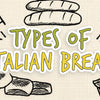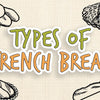Buckwheat Bread: The Complete Baking Guide
Native to Asia and Europe cultivated from the 10th Century for numerous traditional cuisines.
Buckwheat, although commonly classified as a grain (from a culinary perspective) is, in fact, a fruit seed related to sorrel (a French vegetable) and rhubarb.
In this guide, we explore and discover why it has been enjoyed for so long, its nutritional benefits, where it is found, what to do with it once you have it, and how to prepare various recipes with it.
Not Much Time? Skip To What You'd Like To Learn...
-
What is Buckwheat?
-
What is Buckwheat Bread?
-
What Does It Taste Like?
-
Commonly Found Types of Buckwheat
-
5 Health Benefits
-
Side Effects and Concerns
-
Candida
-
Buckwheat Bread Recipes
What is Buckwheat?

-
Wheat? Despite the name wheat, buckwheat is in fact not related to wheat and has commonly been confused as a type of wheat.
-
Grain? Buckwheat is a whole grain related to rhubarb, sorrel, and knotweed - a class of seeds known as pseudocereals.
-
Name? It derives its name from the Dutch word ockweit', which means "beech wheat," reflecting its wheat-like characteristics and beechnut-like shape.
-
Location? Buckwheat is native to the Northern Hemisphere, cultivated in the 10th century China, and Northern Europe because of essential role in traditional cuisines. From there, it spread to other parts of the world including Europe and Russia (14th and 15th Century), and the United States (17th Century) (link).
-
Commercial Production? Currently, buckwheat is widely cultivated and produced commercially in Poland, Russia, US, Canada, and France (famous for French buckwheat crepes).
-
Gluten? Buckwheat contains no protein glutens and can be consumed by people with celiac disease, making it an ideal substitute for oats, wheat, barley or rye. Buckwheat allergies are rare and include tongue and lip swelling, breathing difficulties, and hives (link).
What is Buckwheat Bread?

It is exactly what the name suggests. It is bread baked from buckwheat, a gluten-free fruit seed ground into flour and used to bake products like bread, cakes, cookies, etc. Buckwheat bread is common in many vegan and paleo diets, especially for people looking for whole grains that are gluten-free and rich in protein and fiber (link).
What Does It Taste Like?

Buckwheat is gluten free, which means it lacks the taste and texture of bread baked from wheat or other flours. It contains extremely low levels of starch that gives bread its sweet taste and soft texture. Over time, however, gluten-free bread has improved its taste by honing the recipes and adding flavors like rosemary and garlic (link). In terms of texture, consuming it freshly baked is tastier and has a softer, more bread-like texture.
Commonly Found Types of Buckwheat

Buckwheat exists in two species: Common buckwheat (Fagopyrum asculentum) and Tartary buckwheat (Fagopyrum tartaric).
Both species are commonly ground into flour and used in many ways including baking bread, cakes, and cookies, as well as, making noodles and porridge.
Tartary buckwheat is however more bitter compared to common buckwheat because it contains higher amounts of anti-oxidant compounds like rutin and quercetin.

5 Health Benefits

Buckwheat is undoubtedly one of the healthiest whole grains out there. Whether consumed as bread, porridge or mixed with other foods, buckwheat has numerous health benefits including:
Improves Blood Sugar Control - Consuming buckwheat moderates blood sugar levels and mitigates the chances of developing conditions like diabetes as well as aiding in managing it. It ranks low on the glycemic index - after consumption, the rise in blood sugar levels are slow and gradual compared to other food types. It contains D-chiro-inositol, a soluble carbohydrate that makes it sensitive to insulin and prevents the digestion of table sugar (link).
Promotes Heart Health - Buckwheat contains numerous compounds that promote heart health such as magnesium, rutin, fiber, copper, and phytonutrient like lignans. Rutin, for example, helps prevent the formation of blood clots, which reduces blood pressure, decreases inflammation and promotes overall heart health (link).
Prevents Breast and Intestinal Cancers - Buckwheat is rich in dietary fruit fiber with numerous anti carcinogenic properties including antioxidants and phenolic compounds that help fight and prevent certain types of cancer. Buckwheat contains flavonoids like oligomeric proanthocyanidins that prevent inflammation that contributes to the spread of the disease. Consuming buckwheat does not cure cancer but it helps prevent the development and spread of cancer (link).
Rich Source of Protein - Unlike other grains, buckwheat contains high plant protein levels. Every 100 grams serving contains 14 grams of protein which helps in muscle formation and growth (link). Buckwheat is rich in plant protein, which unlike animal protein is easily digestible and contains useful amino acids. Although the protein content is not as high as in other legumes, it is higher than in other whole grains.
Prevents Digestive Complications - Buckwheat contains 3.4% protein rich in amino acids lysine and arginine that are effective in lowering blood cholesterol (link) reducing the risk of colon cancer (link) and suppressing the formation of gallstones (link).
Side Effects and Concerns

Buckwheat has no known adverse effects except for allergic reactions in some people.
In most cases, buckwheat allergy develops in people who consume buckwheat frequently and in high amounts. It is common in people who are allergic to latex or rice (link), also known as allergic cross-reactivity.
Some common symptoms include digestive distress, skin rashes, and swelling. In extreme cases, the patient may develop severe allergic shock (link).
Candida
What is Candida?
Candida is a common fungus found in various parts of the human body that is generally harmless and useful in digestion and absorption of nutrients from food.
There are over 150 known candida species found in the mouth, vagina, skin, digestive tract, throat, toenails, and rectum (link), but only 15 cause infections especially candida albicans (link). Although generally harmless, an overgrowth of the candida fungus can cause infection (link).
Symptoms - The patient develops symptoms like nausea, diarrhea, bloating, chronic fatigue, eczema, joint pain, anxiety, and depression amongst others.
Risk Factors - The various risk factors for a candida infection include consuming a diet high in refined carbs and sugar, alcohol consumption, overconsumption of yeast, and a generally weak immune system.
Treatment - Although research has examined the risk factors of candida overgrowth, research on treatment remain insufficient and inconsistent (link). However, a candida diet is highly considered as a possible treatment option.
What is a Candida Diet?
It is a restricted diet plan that excludes gluten, sugar, alcohol, and certain dairy products. The diet contains high amounts of non-starchy vegetables, gluten-free, yeast-free foods, and low sugar foods and fruits.
It is meant to reduce inflammation and boost the intake of wholesome foods that are beneficial to your gut and help reduce the risk of developing candida.
Buckwheat Bread and Candida
Consumption of buckwheat helps prevent the development of candida. Buckwheat is gluten-free and low in sugar making it ideal for the diet. It is also ideal due to containing many antioxidants with high anti-inflammatory properties.
Buckwheat Bread Recipes
Buckwheat Bread in a Bread Machine
Inspired by Bread Maker Machines (link)
Ingredients:
-
3 eggs
-
3 tbsp softened butter
-
1 tsp salt
-
1 tsp soy lecithin
-
1 tbsp xanthan gum
-
1 cup milk
-
3 cups pure buckwheat flour
-
1 tbsp yeast
Directions:
1. In the pan, mix all the ingredients in the order indicated above.
2. Bake on the gluten free setting (or soft white if you do not have a gluten free setting), with the loaf size as 1.5 lb and medium crust.
3. Allow the bread to settle for 8-10 minutes once baked
4. Slice and serve.
Buckwheat and Quinoa Bread
Inspired by Tarladalal (link)
Ingredients:
-
1 cup buckwheat flour + 2 tsp for topping
-
1/2 cup quinoa flour
-
2 tbsp flax seeds, powdered + 2 tsp for topping
-
1 tsp sugar
-
1 tsp dry yeast
-
1/4 cup rice flour
-
1/4 cup arrowroot flour
-
1/4 cup corn flour
-
1 tsp salt
Directions:
1. In a deep bowl, combine and mix flaxseed with 1/2 cup warm water and whisk for 2 minutes then set aside.
2. In a small bowl, mix the sugar, yeast, and 2 tbsps warm water, and mix well. Cover the mixture with a lid and set aside for 10 minutes.
3. In another deep bowl, combine the quinoa flour, buckwheat flour, rice flour, arrowroot flour, corn flour, and the two other mixtures. Knead the mixture with warm water into a soft dough.
4. In a greased 7 x 3 inch bread tin, place dough and evenly sprinkle with the 2 tsp buckwheat and flaxseed.
5. Using a damp muslin cloth, cover the tin and set it aside for 40-45 minutes.
6. Preheat oven to 360 degrees F and then bake for 45-50 minutes.
7. Cool your bread and cut into slices.
Buckwheat and Banana Bread Recipe
Inspired by Simple Veganista (link)
Ingredients:
-
1 3/4 cups buckwheat flour
-
1/3 cup coconut sugar
-
2 tsp cinnamon
-
2 tsp baking powder
-
4 large bananas, mashed
-
1/3 cup oil
-
2 tsp vanilla extract
-
salt to taste
Directions:
1. Preheat your oven to 360 degrees F.
2. In a food processor, combine the buckwheat flour, cinnamon, sugar, baking powder, and salt.
3. Add the mashed bananas, vanilla extract, and olive oil and mix.
4. In a greased 9 x 5 inch loaf pan, place your batter and bake for 50-60 minutes.
5. Once cooked, allow to cool for 8-10 minutes
6. Slice and serve immediately.
Buckwheat and Chia Bread
Inspired by The Healthy Chef (link)
Ingredients:
-
1 3/4 cups raw buckwheat groats
-
1/4 cup chia seeds
-
1 cup of water
-
1/4 cup oil
-
1 1/2 tsp baking powder
-
1/2 tsp salt
Directions:
1. Preheat your oven to 320 degrees F.
2. In cold water, soak your buckwheat groats for 2 hours until soft.
3. Soak your chia seeds in 1/2 cup water for about 30 minutes.
4. Sieve the buckwheat until all the water is fully drained.
5. Place your buckwheat in a food processor.
6. Add 1/2 cup of water, chia gel, olive oil, salt, and baking powder and mix thoroughly for 3-4 minutes.
7. Put into a loaf tin and bake for 75-80 minutes.
8. Once baked, allow it to cool for 30 minutes.
9. Cut into slices and serve immediately.
Buckwheat Mix Bread Machine Recipe
Inspired by The Daily Meal (link)
Ingredients:
-
2 1/4 tsp dry yeast
-
3/4 cup buckwheat flour
-
2 2/3 cups bread flour
-
1 1/2 tbsp sugar
-
1 egg
-
3/4 tsp salt
-
1 egg yolk
-
1/4 cup olive oil
-
3/4 cup water
-
1/4 cup sour cream
Directions:
1. Combine and mix all your ingredients in the order above.
2. Bake on the soft white setting, with the loaf size as 1.5 lb and medium crust.
3. Allow the bread to settle for 8-10 minutes once baked
4. Slice and serve.
If you are interested in our top bread slicers, check out our article here (link).









CAN I USE BUCKWHEAT TARTARY FLOUR FOR THESE RECIPES INSTEAD ON PLAIN BUCKWHEAT FLOUR